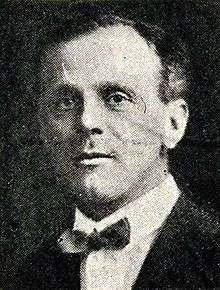Tom Brindle (politician)
| The Honourable Tom Brindle | |
|---|---|
 | |
| 6th President of the Labour Party | |
|
In office 1922–1926 | |
| Vice President |
John Archer (1922-5) Jim Thorn (1926-6) |
| Leader | Harry Holland |
| Preceded by | Frederick Cooke |
| Succeeded by | Bob Semple |
| Member of the New Zealand Legislative Council | |
|
In office 9 March 1936 – 8 March 1950† | |
| Appointed by | Michael Joseph Savage |
| Wellington City Councillor | |
|
In office 1933–1941 | |
| Personal details | |
| Born |
1878 Lancashire or Manchester |
| Died | 19 November 1950 |
| Nationality | New Zealand |
| Political party | Labour Party |
| Other political affiliations | Social Democrat |
Thomas "Tom" Brindle (1878 – 19 November 1950) was a British-born early activist for the New Zealand Labour Party who was jailed during World War I for speaking out against conscription. He was a member of Wellington City Council and stood for election to the House of Representatives five times. He was a member of the Legislative Council from 1936 until March 1950.
Early life in England
Brindle was born in 1878; sources vary whether his place of birth was Lancashire[1] or Manchester.[2] In England, he was active in the Independent Labour Party.[3]
Political career
Brindle emigrated to New Zealand in 1910[3] or 1912,[2] and he became active with the Social Democratic Party.[2] He was jailed in 1916 during World War I for speaking out against conscription.[4][5] He stood for secretaryship of the New Zealand Labour Party in 1919, but withdrew and Michael Joseph Savage became the first full-time paid secretary.[6] Brindle stood again in 1920, but lost the ballot. From 1922 to 1926, he was the 6th President of the Labour Party.[2]
Brindle unsuccessfully stood five times for the House of Representatives.[3] In 1919 and 1922, he was one of three candidates in the Gisborne electorate, and he came last on both occasions.[7][8] In 1925, he was one of three candidates in the Nelson electorate, and he again came last.[9] In 1928 and 1931, he was one of three candidates in the Wellington Suburbs electorate, and he came second on both occasions.[10][11][12]
Brindle was first elected to Wellington City Council in 1933 after standing unsuccessfully several times prior[1] and remained on the city council until 1941, the same year all Labour local body members in Wellington lost their seats.[2] He was appointed to the Legislative Council by the First Labour Government under Michael Joseph Savage and was one of 14 new appointments. At the time of his appointment, he lived in Wellington.[13]
In 1935, he was awarded the King George V Silver Jubilee Medal.[14]
Brindle was a member of the New Zealand Legislative Council from 9 March 1936 to 8 March 1943; and 9 March 1943 to 8 March 1950.[15]
Death
Brindle died on 19 November 1950.[16]
Notes
- 1 2 "Upper House". Auckland Star. LXVII (59). 10 March 1936. p. 9. Retrieved 4 March 2014.
- 1 2 3 4 5 Gustafson 1980, p. 155.
- 1 2 3 "Biographical Notes". The Evening Post. CXXI (59). 10 March 1936. p. 10. Retrieved 4 March 2014.
- ↑ Greenaway, Richard L. N. (June 2007). "Sydenham Cemetery Tour" (PDF). Christchurch City Libraries. p. 16. Retrieved 30 July 2013.
- ↑ "Crimes (Repeal of Seditious Offences) Amendment Bill — Second Reading". New Zealand Parliament. Retrieved 5 March 2014.
- ↑ Gustafson 1980, p. 139.
- ↑ The New Zealand Official Year-Book. Government Printer. 1920. Retrieved 2 August 2013.
- ↑ "Official Counts". The Evening Post. CIV (144). 15 December 1922. p. 8. Retrieved 3 March 2014.
- ↑ "South Island". Otautau Standard and Wallace County Chronicle. XXI (1055). 10 November 1925. p. 1. Retrieved 5 March 2014.
- ↑ The General Election, 1928. Government Printer. 1929. p. 6. Retrieved 4 December 2013.
- ↑ "Declaration of Result of Poll for the Electoral District of Wellington Suburbs". New Zealand Truth (1200). 29 November 1928. p. 14. Retrieved 5 March 2014.
- ↑ "Declaration of Result of Poll for the Electoral District of Wellington Suburbs". The Evening Post. CXII (140). 10 December 1931. p. 2. Retrieved 5 March 2014.
- ↑ "Legislative Council". The Evening Post. CXXI (59). 10 March 1936. p. 10. Retrieved 4 March 2014.
- ↑ "Official jubilee medals". The Evening Post. CXIX (105). 6 May 1935. p. 4. Retrieved 19 March 2014.
- ↑ Wilson, James Oakley (1985) [First edition published 1913]. New Zealand Parliamentary Record, 1840–1984 (4th ed.). Wellington: V.R. Ward, Govt. Printer. p. 150. OCLC 154283103.
- ↑ "Obituary". Evening Star. 20 November 1950.
References
- Gustafson, Barry (1980). Labour's path to political independence: The Origins and Establishment of the New Zealand Labour Party, 1900–19. Auckland, New Zealand: Auckland University Press. ISBN 0-19-647986-X.
| Party political offices | ||
|---|---|---|
| Preceded by Frederick Cooke |
President of the Labour Party 1922–1926 |
Succeeded by Bob Semple |